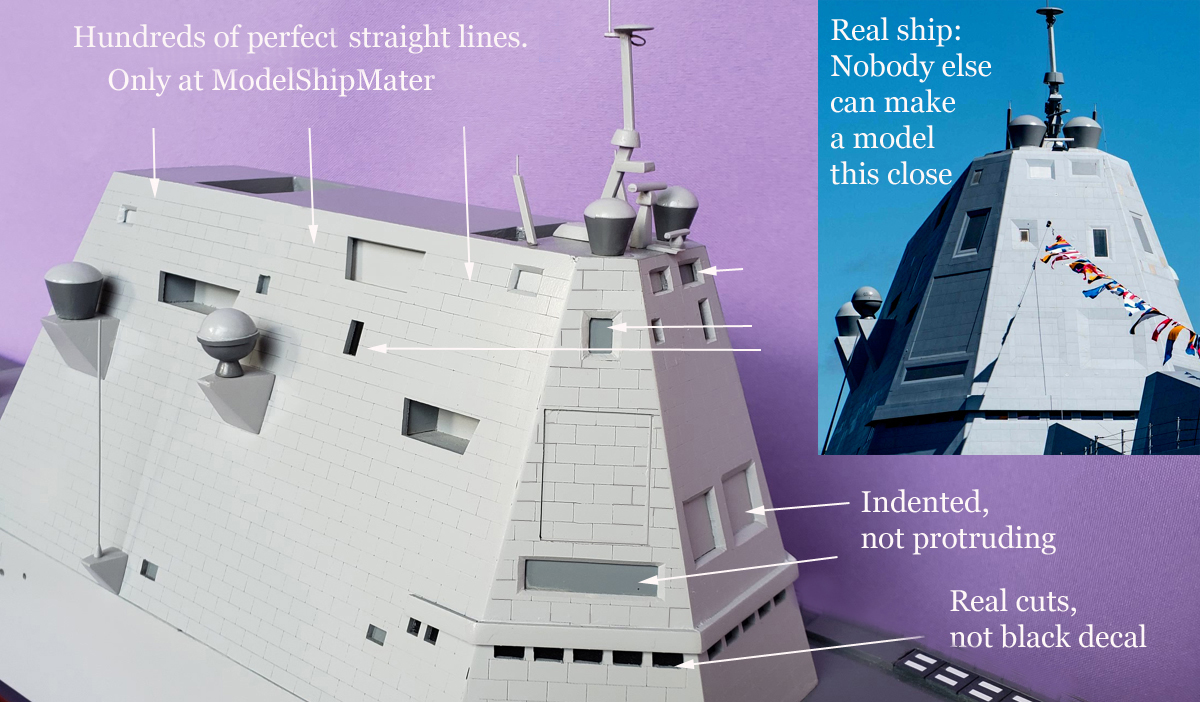|
ZUMWALT CLASS
The Zumwalt class
is a guided missile destroyer class of the United
States Navy. The class's sheer magnitude commands
awe, boasting a great length of 610
feet and a displacement exceeding 15,000 tons. Its appearance immediately catches the eye
with futuristic and sleek design, reminiscent of a
science fiction vessel. Notably, the ship's bow
forms a razor-sharp edge. This striking design is not
just for aesthetics; it plays a crucial role in the
ship's capabilities.

The Zumwalt class looks like
a small fishing boat during radar testing. Taking a
look at her external shape. There are fewer edges, a
conspicuous absence of protruding structures or
varied contours and a flat side, seamlessly attached
to the upper deck of the ship, on a straight, yet
slightly angled flat linear surface. Most
current destroyers have multiple deck-mounted
sensors, weapons systems and angular staircases
visibly positioned on the deck of the ship; none of
this can be seen on the Zumwalt class. Most of Zumwalt’s
weapons are housed in what
appear to be rounded, cone-like structures.
The Zumwalt’s electric-drive propulsion system
is also much quieter -- giving the ship a smaller
signature for overhead enemy sensors. Her
wave-cutting Tumblehome hull is much more narrowly
built than existing destroyers, making it less
detectable to submarine sonar.

The innovative Integrated Power System is
another characteristic that sets Zumwalt class apart from
its predecessor. Unlike conventional destroyers
relying solely on gas turbines, the Zumwalt's IPS
combines advanced electric propulsion with gas
turbine engines, delivering unparalleled efficiency
and adaptability. The IPS incorporates
state-of-the-art Rolls Royce-designed generators,
integrated into the system by General Electric.
While the exact maximum power output remains
undisclosed to the public, it is widely known to far
surpass that of the Arleigh Burke class.
Her design with excess requirements allows the Navy
to experiment with nearly any new system, paving the
way for potential testing of advanced energy-based
weaponry, such as railguns, sonic, and lasers.

Destroyers' bridge,
which typically requires a crew of about five to 10
sailors on the Arleigh Burke-class, can be
effectively managed by a single sailor if necessary
on the Zumwalt class. Multiple systems are centralized and
controlled through panels on the bridge. The ship is
designed to allow a single sailor to steer and take
command in emergencies.
The Zumwalt class is
designed as a flexible ship, capable of carrying out
a wide variety of missions. Unlike previous destroyer
classes, designed primarily for deep-water combat,
the Zumwalt class was primarily designed to support
ground forces in land attacks. They also perform the
usual destroyer missions of anti-air, anti-surface,
and antisubmarine warfare.


This primarily wood,
1/200 scale, model of the USS Zumwalt is 37" long x 13" tall x 5" wide
(7" with base)
$2,490
 shipping and insurance
in the US included. Other countries: $300 flat rate.
This model is in
stock and can be shipped within 5 business days.
shipping and insurance
in the US included. Other countries: $300 flat rate.
This model is in
stock and can be shipped within 5 business days.
20.5" long (1/350
scale)
$1,950
shipping and insurance
in the US included. Other countries: $200 flat rate.
By commissions only.
We require only a small deposit to start the process. The
remaining balance won't be due until the model is
completed, in
several months.


Nobody builds better
warships than ModelShipMaster.
Click
here
to find out.
Learn more about the
Zumwalt class here:
https://en.wikipedia.org/wiki/Zumwalt-class_destroyer
|